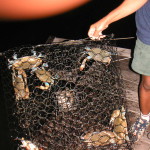Sargent Canals
The Sargent Canal system along with Caney Creek provide another unique fishing habitat. If you own land on the canals you can catch a Redfish in your backyard.
The Sargent Canal system is a vast canal system that was created in the 1960’s offer great fish habitat into our Bay and Ocean. Our vast network of canals offer good water flow between the gulf and wetlands because they span both North and South and then East and West.Water is always moving from the winds and tides. This movement keeps the canals from getting stagnant and provides a good life zone for habitat crabs, fish and birds.
View Sargent Canal System and Caney Creek in a larger map
View fishsargent Ancient Creek in Blue in a larger map
 .
.
View fishsargent Ancient Creek in Blue in a larger map
Caney Creek
Caney Creek is located in (Matagorda County & Wharton County). The original name of Caney Creek was Canebrake Creek. Canebrake used to grow on it’s banks.
It was a natural river flowing through the plains and its source was in Wharton County. Its source is (at 29°26′ N, 96°18′ W). It runs southeast through rich coastal plains for 155 miles to its mouth on the Gulf Intracoastal Waterway, and then into East Matagorda Bay 5½ miles southeast of Sargent, Matagorda County (at 28°46′ N, 95°39′ W).
Sargent Fact: Caney Creek was ancient mouth of Southern Colorado River
Caney Creek was once the mouth of Colorado river that flowed into the Gulf of Mexico. Several thousand thousand years have passed since Caney Creek was the Colorado River. It used to empty into the bay and then the Gulf of Mexico.
Historically the change in the flow occurs a mile west of Glen Flora at (at 29°21′ N, 96°13′ W) then they separated again at(at 29°20′ N, 96°12′ W). The modern stream meanders through that area then it enters Matagorda County. At this point the river is an intermittent stream then it starts to take on water and from several sloughs and drainage areas to become a flowing river. Most areas along the Creek are used for Cattle production which keeps the land relatively free from any industrialization. The Greater Sargent ecosystem including Caney Creek is part of the Great “Columbia Bottom Land” Forest Preservation effort by many different private groups including the National Forest Service.
Sargent Around Civil War Years
The early history of Caney Creek revolves around the rich alluvial lands surrounding the Creek have been described by notes some early surveyors. The land was great for planting Sugar Cane. The Texas historical society describes Caney Creek:
The Creek and some areas around it for Years Old Three Hundred settler Elias R. Wightman and elsewhere, made it a focal point for settlement in the 1820s (see ANGLO-AMERICAN COLONIZATION).
Before planting early colonist would burn the Canebrake. Canebrake is a native bamboo like plant native to Texas. This burning would enrich the soil. Many grassland burns still go one in both the San Bernard Reservation and the fields to the West of Sargent Texas. The Creek was navigable for some distance upstream. Sugar production was very successful and then Cotton. Many homes sprung up on the creeks shoreline. In 1825 Robert Harris Williams established one of the first cotton gins in colonial Texas on the banks of Caney Creek.
Confederate Troops: Guard Yankees and prevent entrance to Caney Creek!
During the Civil War, Confederate commander John Bankhead Magruder had the mouth of Caney Creek fortified as part of a strategy to stop the federal advance north along the coast toward Galveston. In January and February 1864, federal gunboats bombarded the area, which was reportedly defended by 4,000 to 6,000 Confederate troops. No ground combat occurred, and by March Magruder had shifted the troops elsewhere. A Texas Historical Commission marker at the site commemorates the defense.
A 1975 archaeological survey including the Caney Creek area noted the ruins of a sugar mill and sawmill on the creek’s side banks, and the sunken remains of a paddle wheeler. The study recommended that the creek-side remains of James Boyd Hawkins’s nineteenth-century plantation house be considered for renovation.
It also noted the presence, of the settlement dwindling at that time because of ongoing subdivision and development of the preferred Creekside land.
Citation:
“CANEY CREEK (WHARTON COUNTY),” Handbook of Texas Online(http://www.tshaonline.org/handbook/online/articles/rbc47), 2013. Published by the Texas State Historical Association.
BIBLIOGRAPHY:
Gayle Jeannine Fritz, Matagorda Bay Area, Texas (Research Report 45, Texas Archeological Survey of the University of Texas at Austin, 1975). Matagorda County Historical Commission, Historic Matagorda County (3 vols., Houston: Armstrong, 1986). Marker Files, Texas Historical Commission, Austin.
Citation: The following, adapted from the Chicago Manual of Style, 15th edition, is the preferred citation for this article.CANEY CREEK (WHARTON COUNTY),” Handbook of Texas Online(http://www.tshaonline.org/handbook/online/articles/rbc47) 2013.


2 Responses to Canals & Creek